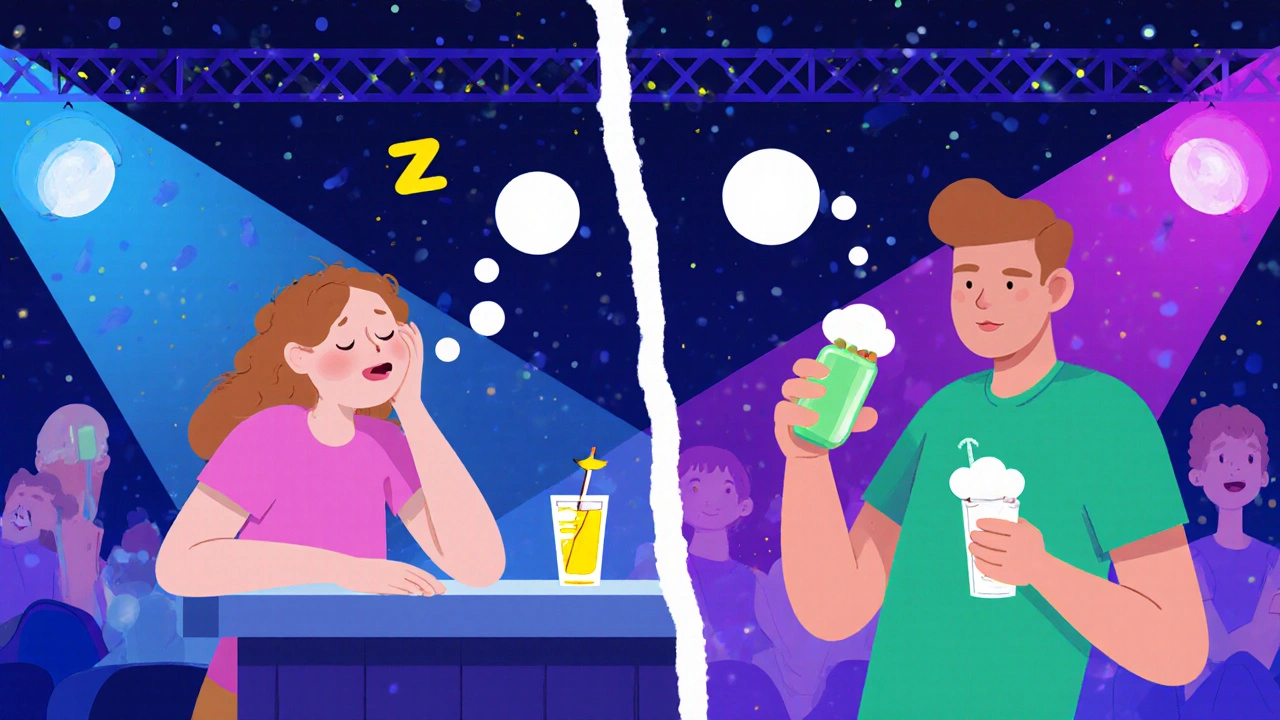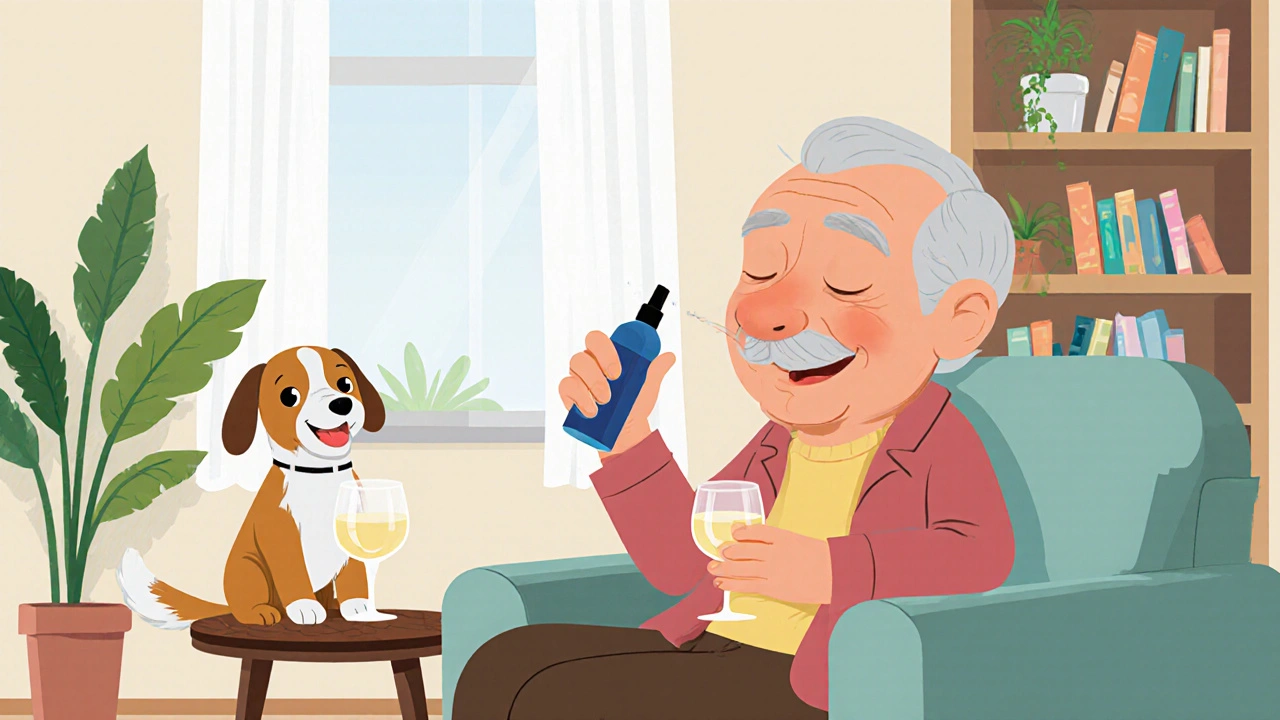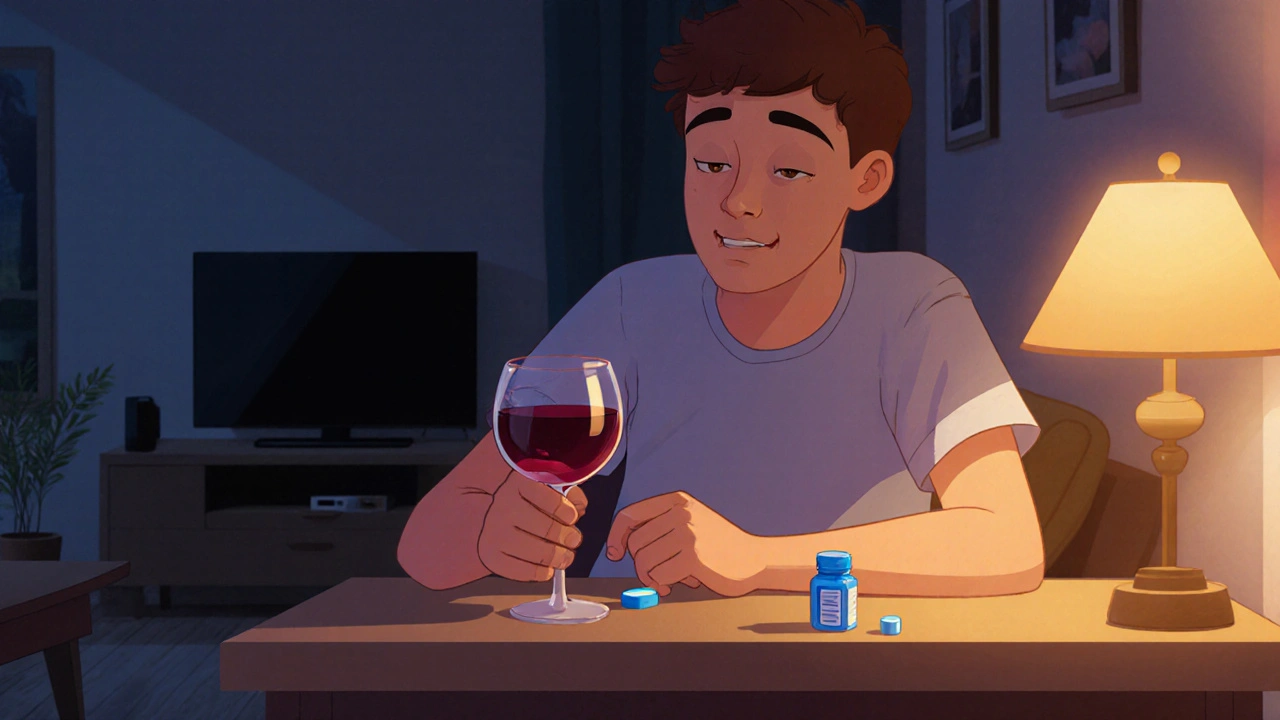Antihistamine-Alcohol Interaction Risk Calculator
This tool calculates your drowsiness risk when combining antihistamines with alcohol based on scientific data from the article.
Risk Assessment
Mixing antihistamines and alcohol isn’t just a harmless weekend shortcut - it’s a recipe for amplified drowsiness, impaired judgment, and potentially life‑threatening accidents. Below you’ll find the science behind the interaction, real‑world data on how severe the sedation can get, and practical steps to keep yourself safe if you’re dealing with allergies and a social drink.
Key Takeaways
- Both first‑ and second‑generation antihistamines become far more sedating when combined with alcohol.
- First‑generation drugs such as diphenhydramine can boost alcohol‑induced impairment by up to 300%.
- Older adults face a 2.3‑fold increase in CNS depression and a dramatically higher fall risk.
- Waiting 12‑16 hours after a first‑generation antihistamine before drinking is the safest rule of thumb.
- Non‑sedating alternatives like nasal corticosteroids or leukotriene inhibitors avoid the interaction entirely.
What Are Antihistamines?
Antihistamines are a class of drugs that block histamine H1 receptors, reducing allergy symptoms such as sneezing, itching, and runny nose. They fall into two broad categories. First‑generation antihistamines, introduced in the 1940s, cross the blood‑brain barrier and cause marked sedation. Second‑generation antihistamines, launched in the 1990s, were engineered to stay out of the brain, offering “non‑drowsy” relief for most users.
How Alcohol Interacts with Antihistamines
Alcohol itself is a central nervous system (CNS) depressant. It boosts gamma‑aminobutyric acid (GABA) activity and dampens NMDA receptors, leading to relaxation and slower reaction times. When you add an antihistamine that also depresses the CNS, the two effects don’t just add - they multiply.
The National Institute on Alcohol Abuse and Alcoholism (NIAAA) reports a 300 % increase in drowsiness when the two are taken together, meaning a sip of wine while on a tablet can feel like a double dose of a sleep aid. Metabolically, alcohol inhibits CYP3A4 and CYP2D6 enzymes, which are responsible for breaking down many antihistamines. The result? Blood levels of the drug stay 25‑40 % higher for longer, extending the window of danger.

First‑Generation vs. Second‑Generation: A Side‑by‑Side Look
| Antihistamine | Generation | Typical Drowsiness (alone) | Drowsiness With Alcohol | Typical Dose |
|---|---|---|---|---|
| Diphenhydramine (Benadryl) | First | ~50 % | 30‑60 % | 25 mg (1 tablet) |
| Loratadine (Claritin) | Second | 10‑15 % | 30‑35 % | 10 mg (once daily) |
| Cetirizine (Zyrtec) | Second | 15‑20 % | 40‑45 % | 10 mg (once daily) |
The numbers come from GoodRx, Healthline, and MedicalNewsToday studies conducted in 2023. Even the “non‑drowsy” options see a sharp jump in sedation when alcohol is in the mix.
Real‑World Consequences
Data from the CDC shows that 28 % of traffic fatalities in 2021 involved drivers with measurable levels of both a sedating medication and alcohol. The American College of Allergy, Asthma & Immunology (ACAAI) warns that mixing these substances can impair reaction time by up to 47 % compared with alcohol alone.
Older adults are hit hardest. A 2022 Journal of the American Geriatrics Society study found people 65 + experience 2.3 × greater CNS depression, leading to a 75 % higher risk of falls and hip fractures. In practical terms, taking two Benadryl tablets with three drinks can push a person’s functional blood‑alcohol concentration (BAC) to 0.12‑0.15 % - well above the legal limit of 0.08 % in the U.S.
Why the Misconception Persists
Many users see the “non‑drowsy” label and assume it’s safe to drink. The truth is that the label only means the drug causes less sedation under normal conditions; it doesn’t eliminate the interaction. Dr. Purvi Parikh, an allergist with the AAAAI, says, “the misconception that non‑drowsy antihistamines are safe with alcohol is dangerous-while the risk is lower, it’s certainly not eliminated.”
OTC packaging adds to the confusion. GoodRx notes that diphenhydramine appears in 72 different OTC products, ranging from sleep aids to cold medicines. Only prescription antihistamines carry a prominent black‑box warning about alcohol, while many OTC labels simply state “may cause drowsiness,” omitting the alcohol warning completely.

Practical Guidance for Consumers
If you must take an antihistamine and you plan to drink, follow these safe‑use rules:
- Identify the generation. Check the active ingredient; diphenhydramine, chlorpheniramine, or doxylamine are first‑generation and highly sedating.
- Time your intake. Wait at least 12‑16 hours after a first‑generation dose before drinking. For second‑generation agents, aim for an 8‑12 hour window.
- Limit alcohol. One standard drink (≈14 g alcohol) is about as much as your body can handle without severe additive sedation. Anything above that dramatically raises risk.
- Watch for symptoms. If you feel unusually sleepy, dizzy, or notice slowed reactions, stop drinking and avoid driving.
- Consider alternatives. Nasal corticosteroids (e.g., Flonase) and leukotriene inhibitors (e.g., Singulair) have no known alcohol interaction, though they need a few days to reach full effect.
For people with chronic allergies who enjoy social drinks, switching to a nasal spray or a leukotriene blocker can maintain symptom control without the dangerous synergy.
Looking Ahead: New Generation Antihistamines
Pharma companies are working on third‑generation antihistamines such as bilastine, which in European trials showed virtually no CNS penetration even with alcohol. However, FDA approval in the U.S. is still years away. Until those hit the market, the safest approach remains: treat any antihistamine‑alcohol combination as high‑risk.
Frequently Asked Questions
Can I take a non‑drowsy antihistamine and have a glass of wine?
Yes, but with caution. Even second‑generation antihistamines like loratadine or cetirizine can increase drowsiness when paired with alcohol, especially if you exceed one drink. The safest move is to keep alcohol intake low and wait several hours after the dose.
How long should I wait after taking Benadryl before drinking?
Aim for at least 12‑16 hours. This allows the drug’s plasma concentration to fall enough that the added depressant effect of alcohol is minimized.
Are there any antihistamines that are completely safe with alcohol?
No antihistamine is 100 % safe when mixed with alcohol. Even the newest third‑generation candidates still show a measurable increase in sedation in clinical trials.
What symptoms should make me stop drinking immediately?
Sudden extreme sleepiness, difficulty focusing, slowed speech, or loss of coordination are red flags. If any appear, put down the drink and seek a safe place to rest.
Do over‑the‑counter cold medicines pose the same risk?
Many OTC cold formulas contain first‑generation antihistamines like diphenhydramine or chlorpheniramine. The same interaction rules apply-avoid alcohol for at least 12‑16 hours after taking them.
Bottom line: mixing antihistamines and alcohol dramatically boosts drowsiness and impairs judgment. Understanding which generation you’re using, respecting timing windows, and opting for non‑sedating alternatives can keep you safe while still managing those pesky allergy symptoms.


Comments (8)
Buddy Bryan
October 24, 2025 AT 19:55Let me break down why mixing antihistamines with alcohol is a straight‑up hazard. First, first‑generation antihistamines like diphenhydramine cross the blood‑brain barrier and already produce a hefty dose of sedation on their own. Add ethanol, a central nervous system depressant, and you’re not just adding two effects – you’re multiplying them, pushing drowsiness up by three‑hundred percent in some studies. The metabolic pathway compounds the problem: alcohol inhibits CYP3A4 and CYP2D6 enzymes, which are responsible for breaking down many antihistamines, so the drug sticks around longer and at higher concentrations. That prolonged exposure means the window of impaired judgment extends far beyond the typical half‑life of the medication. For older adults the stakes are even higher; a 2022 geriatric study showed a 2.3‑fold increase in CNS depression, translating to a massive rise in fall risk and hip fractures. Driving under those conditions is comparable to driving with a blood‑alcohol level well over the legal limit, often around 0.12‑0.15 % after just a couple of drinks. Even “non‑drowsy” second‑generation antihistamines aren’t exempt – they still see a jump in sedation when paired with alcohol, as the data from GoodRx and Healthline illustrate. The safest rule of thumb is to wait at least twelve to sixteen hours after taking a first‑generation antihistamine before you reach for a cocktail, and eight to twelve hours for a second‑generation drug. If you can’t wait, switch to a nasal corticosteroid or a leukotriene inhibitor, which have no known interaction with alcohol. Lastly, be aware that many over‑the‑counter cold medicines hide first‑generation antihistamines under brand names, so always read the active ingredient list before you pour a drink. In short, the combination dramatically amplifies sedation, impairs reaction time, and elevates accident risk – treat it as a high‑risk scenario and plan accordingly.
Veronica Appleton
October 31, 2025 AT 18:35Totally agree with the precautionary steps – checking the ingredient list is key. If you’re stuck with an OTC combo, wait longer than usual. It’s better to be safe than sorry.
Jonah O
November 7, 2025 AT 17:15Yo the gov dont tell u the real reason they push benadryl with booze-it's a mind control cocktail they dont want u to notice, cause the sedate effect masks the truth, you think u just "sleepy" but they are quietiing dissent.
read between the lines, the pharma lobby is all about keeping the masses docile.
Grace Silver
November 14, 2025 AT 15:55Interesting perspective – the safety data does suggest a real pharmacological risk beyond any hidden agenda. While conspiracy theories can be compelling, the peer‑reviewed studies provide concrete evidence of increased drowsiness and impaired motor function when these substances mix. It’s prudent to follow the guidelines regardless of the underlying motivations.
Aaron Kuan
November 21, 2025 AT 14:35Mixing them turns a night out into a nap.
Amber Lintner
November 28, 2025 AT 13:15Oh, the drama! Imagine thinking you’re the life of the party, only to be overtaken by a wave of unintentional slumber that could have been avoided. It’s almost tragic how we ignore such glaring warnings, only to blame fate when the curtains close early. The real culprit is that reckless confidence that blinds us to simple science.
the sagar
December 5, 2025 AT 11:55Our country’s health is at stake when people ignore common sense; stop drinking with meds.
Clinton Papenfus
December 9, 2025 AT 19:55In conclusion the prudent approach is to respect pharmacological guidelines and avoid alcohol when using antihistamines; such adherence safeguards both personal health and public safety.